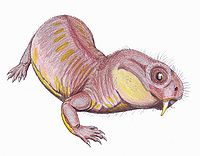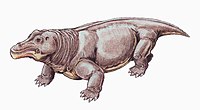Capitanian
Template:Permian In the geologic timescale, the Capitanian is an age or stage of the Permian. It is also the uppermost or latest of three subdivisions of the Guadalupian epoch or series. The Capitanian lasted between 264.28 and 259.51 million years ago. It was preceded by the Wordian and followed by the Wuchiapingian.[1]
A significant mass extinction event (the End-Capitanian extinction event) occurred at the end of this stage, which was associated with anoxia and acidification in the oceans and possibly caused by the volcanic eruptions that produced the Emeishan Traps.[2] This extinction event may be related to the much larger Permian–Triassic extinction event that followed about 10 million years later.
Stratigraphy
The Capitanian stage was introduced into scientific literature by George Burr Richardson in 1904. The name comes from the Capitan Reef in the Guadalupe Mountains (Texas, United States). The Capitanian was first used as a stratigraphic subdivision of the Guadalupian in 1961,[3] when both names were still only used regionally in the southern US. The stage was added to the internationally used ICS timescale in 2001.[4]
Definitions
The base of the Capitanian stage is defined as the place in the stratigraphic record where fossils of conodont species Jinogondolella postserrata first appear. The global reference profile for this stratigraphic boundary is located at Nipple Hill in the southern Guadalupe Mountains of Texas.
The top of the Capitanian (the base of the Wuchiapingian and Lopingian series) is defined as the place in the stratigraphic record where the conodont species Clarkina postbitteri postbitteri first appears.
The Capitanian stage was part of the time in which the Zechstein was deposited in Europe.[1] It is coeval with the old European regional Saxonian stage. In the eastern Tethys domain, the Capitanian overlaps the regional Murgabian stage, the Midian stage and the lower part of the Laibinian stage. In Russia the Capitanian equals the lower part of the regional Severodvinian stage.
Biostratigraphy
The Capitanian contains one ammonite biozone (Timorites) and three conodont biozones:
- zone of Clarkina postbitteri hongshuiensis
- zone of Jinogondolella altudaensis
- zone of Jinogondolella postserrata
Larger fusulinid species permit a division in two biozones:
- zone of Rausserella
- zone of Afganella schenki
Biodiversity
Olson’s Extinction, in the early Guadalupian (Roadian, Wordian), led to an extended period of low diversity when worldwide two-thirds of terrestrial vertebrate life was lost.[5] Global diversity rose dramatically in the Capitanian, probably the result of disaster taxa filling empty guilds, only to fall again when the end-Guadalupian event caused a diversity drop in the Wuchiapingian.[6]
Events
Carbon isotopes in marine limestone from the Capitanian age show an increase in δ13C values. The change in carbon isotopes in the sea water reflects cooling of global climates.[7]
This climatic cooling may have caused the end-Capitanian extinction event among species that lived in warm water, like larger fusulinids (Verbeekninidae), large bivalves (Alatoconchidae) and rugose corals, and Waagenophyllidae.[8]
Capitanian Life
Arthropods
†Trilobites
| Trilobita of the Capitanian | ||||
|---|---|---|---|---|
| Taxa | Presence | Location | Description | Images |
| Guadalupian | Japan | A proetid |
 | |
| Carboniferous to Guadalupian | Oman, United States | A proetid | ||
Actinopterygians
| Actinopterygii of the Capitanian | ||||
|---|---|---|---|---|
| Taxa | Presence | Location | Description | Images |
| Carboniferous to Lopingian | Russia | A non-neopterygian |
 | |
| Permian | Russia | A non-neopterygian | ||
†Chroniosuchians
| Chroniosuchia of the Capitanian | ||||
|---|---|---|---|---|
| Taxa | Presence | Location | Description | Images |
| Guadalupian to Lopingian | Russia | A reptiliomorph |
  | |
| Guadalupian | Russia | A reptiliomorph | ||
†Temnospondyli
| Temnospondyls of the Capitanian | ||||
|---|---|---|---|---|
| Taxa | Presence | Location | Description | Images |
|
Karoo Supergroup, South Africa | A species of stereospondyl amphibian in the family Rhinesuchidae, formerly placed in the genus Rhinesuchus. |
 | |
|
Karoo Supergroup, South Africa | A species of stereospondyl amphibian in the family Rhinesuchidae, it's the type species the genus Rhinesuchus. | ||
†Procolophonomorphs
| Procolophonomorpha of the Capitanian | ||||
|---|---|---|---|---|
| Taxa | Presence | Location | Description | Images |
| Guadalupian | South Africa | A pareiasaurid parareptile |
 | |
Synapsids (non-therapsid)
| Synapsida of the Capitanian | ||||
|---|---|---|---|---|
| Taxa | Presence | Location | Description | Images |
| Guadalupian | South Africa | A varanopid |
 | |
| Guadalupian | South Africa | A varanopid | ||
| Guadalupian | Russia | A varanopid | ||
Therapsids
References
- ^ a b Gradstein, F.M.; Ogg, J.G. & Smith, A.G.; 2004: A Geologic Time Scale 2004, Cambridge University Press
- ^ Bond, D. P. G.; Wignall, P. B.; Joachimski, M. M.; Sun, Y.; Savov, I.; Grasby, S. E.; Beauchamp, B.; Blomeier, D. P. G. (2015-04-14). "An abrupt extinction in the Middle Permian (Capitanian) of the Boreal Realm (Spitsbergen) and its link to anoxia and acidification" (PDF). Geological Society of America Bulletin. 127 (9–10): 1411–1421. doi:10.1130/B31216.1. ISSN 0016-7606.
- ^ Glenister, B.F. & Furnish, W.M.; 1961: The Permian ammonoids of Australia, Journal of Paleontology 35(4), pp 673–736.
- ^ Glenister, B.F.; Wardlaw, B.R.; Lambert, L.L.; Spinosa, C.; Bowring, S.A.; Erwin, D.H.; Menning, M. & Wilde, G.L.; 1999: Proposal of Guadalupian and Component Roadian, Wordian and Capitanian Stages as International Standards for the Middle Permian Series, Permophiles 34: pp 3–11.
- ^ Bond, David; Hilton, Jason (2010). "The Middle Permian (Capitanian) mass extinction on land and in the oceans". Earth-Science Reviews. 102 (1): 100–116. doi:10.1016/j.earscirev.2010.07.004.
- ^ Sahney, S.; Benton, M.J. (2008). "Recovery from the most profound mass extinction of all time". Proceedings of the Royal Society B: Biological Sciences. 275 (1636): 759–65. doi:10.1098/rspb.2007.1370. PMC 2596898. PMID 18198148.
- ^ Isozaki, Yukio; Kawahata, Hodaka; Ota, Ayano (2007). "A unique carbon isotope record across the Guadalupian–Lopingian (Middle–Upper Permian) boundary in mid-oceanic paleo-atoll carbonates: The high-productivity "Kamura event" and its collapse in Panthalassa". Global and Planetary Change. 55 (1–3): 21–38. doi:10.1016/j.gloplacha.2006.06.006.
- ^ Isozaki, Yukio; Aljinović, Dunja (2009). "End-Guadalupian extinction of the Permian gigantic bivalve Alatoconchidae: End of gigantism in tropical seas by cooling". Palaeogeography, Palaeoclimatology, Palaeoecology. 284 (1–2): 11–21. doi:10.1016/j.palaeo.2009.08.022. ISSN 0031-0182.
External links
- GeoWhen Database - Capitanian
- Upper Paleozoic stratigraphic chart at the website of the subcommission for stratigraphic information of the ICS









